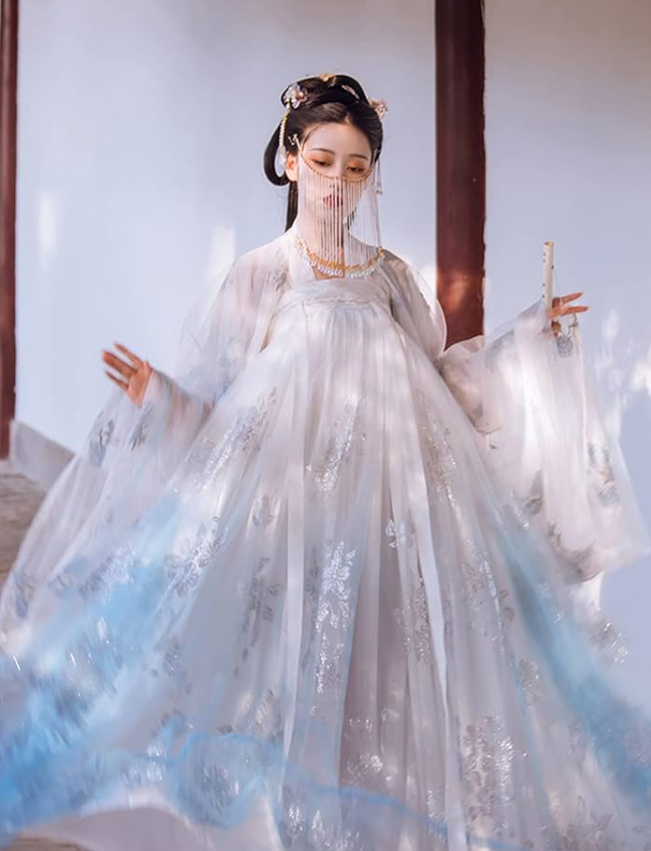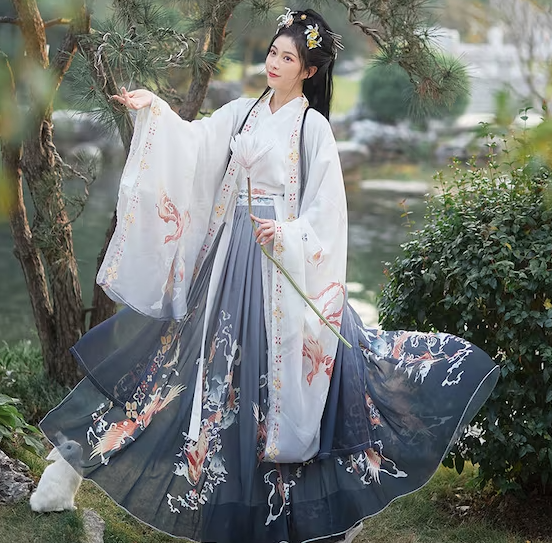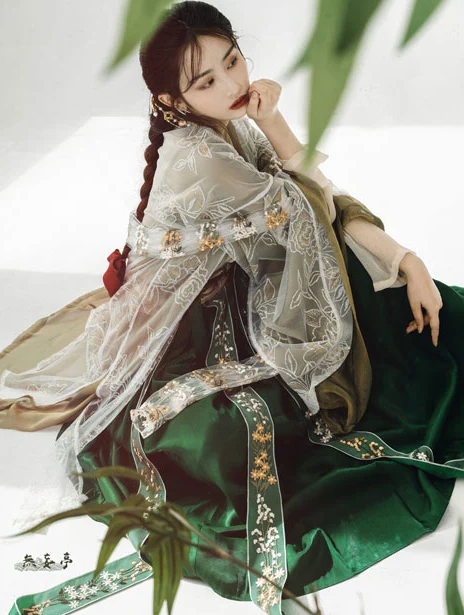Yes, you can wear hanfu to prom to showcase and celebrate your cultural heritage confidently.
The Cultural Significance of Hanfu
Hanfu is more than just a style of clothing; it represents a deep and rich history of China, reflecting its cultural, societal, and artistic values. The flowing robes, intricate patterns, and unique designs are not merely aesthetic choices but carry the weight of thousands of years of Chinese history.

Hanfu’s Roots and History
Originating from the Han Dynasty, Hanfu has been a significant part of China’s history for over two millennia. As dynasties rose and fell, the styles and designs of Hanfu evolved, each reflecting the values and artistic expressions of its time. During the Tang Dynasty, Hanfu became more diverse, with influences from bordering nations incorporated into its design, while the Ming Dynasty saw a return to more traditional patterns and colors.
Throughout its history, Hanfu has been more than just a fashion statement. It was a reflection of social status, occupation, and even moral values. For example, scholars often wore robes with large sleeves, indicating their detachment from manual labor.
Modern Day Revival of Hanfu
Today, there is a resurgence in the popularity of Hanfu, especially among the younger generation in China. Modern interpretations of these traditional garments blend ancient designs with contemporary fashion elements, creating a bridge between the past and the present. Events like Hanfu parades and festivals are becoming increasingly popular, and many young people proudly wear Hanfu to reconnect with their heritage.
Prom Night Fashion Evolution
Prom night, a quintessential rite of passage for many American teenagers, has seen a multitude of fashion trends over the years. From modest beginnings in the 1920s to the extravagant designs of today, prom fashion encapsulates the evolving cultural zeitgeist of each decade.
Western Prom Gowns: A Brief History
Prom, short for “promenade”, began as a simple event in the early 20th century, where college students dressed in their Sunday best for a tea dance. As the event trickled down to high schools and grew in significance, the fashion began to change and adapt.
The 1950s saw the rise of ballerina-length dresses with cinched waists, reflecting the post-war era’s optimism and the influence of icons like Audrey Hepburn. Moving into the rebellious 1960s and 70s, hemlines went up, and bright psychedelic patterns became all the rage. The 1980s, inspired by TV shows and Hollywood, brought the age of big hair, puffed sleeves, and sequined gowns.
The new millennium introduced a broader range of styles, from sleek and minimalistic designs to intricate and lavish creations. Trends began to shift faster, often influenced by celebrities on the red carpet, signaling a prom fashion world always in flux and keenly aware of the latest fads.
Fusion of Cultures: Incorporating Ethnic Wear
In recent years, with the rise of global interconnectedness, prom-goers are increasingly looking beyond the traditional Western-style gowns. Many are embracing their cultural heritage, donning outfits that represent their ethnic backgrounds.
Potential Reactions to Wearing Hanfu at Prom
Choosing to wear Hanfu to prom is a bold and unique fashion statement, and reactions can span a broad spectrum. While many people will appreciate the beauty and significance of the attire, some might misunderstand or stereotype the choice. It’s essential to be prepared for a range of responses and know how to navigate potential conversations.
Positive Reactions: Appreciation & Interest
Wearing Hanfu can garner a lot of admiration and intrigue. Many will be captivated by the elegance, intricate designs, and historical significance of the attire. Classmates, teachers, and even photographers might approach you with genuine questions about the garment’s origin, the materials used, or the story behind your choice to wear it.
Prom is a celebration, and wearing Hanfu offers an opportunity to share a piece of rich Chinese culture with others. It can spark enlightening conversations and can be an eye-opener for many who might not be familiar with such traditional garments.
Negative Reactions: Misunderstandings & Stereotypes
Unfortunately, not all reactions might be positive. Some might jump to conclusions or rely on stereotypes about Asian cultures. There might be comments or jokes that stem from ignorance or misconceptions. While the hope is that these instances are few and far between, being mentally prepared is essential.
It’s crucial to remember that wearing Hanfu is a celebration of heritage, and negative comments say more about the commenter’s ignorance than the garment itself. Surrounding oneself with supportive friends can also help navigate any uncomfortable situations that may arise.
Tips to Educate and Inform Others about Hanfu
- Be Prepared with Facts: Knowing the history and significance of Hanfu will allow you to answer questions and address misconceptions. You can share how Hanfu dates back to the Han Dynasty and its recent resurgence in modern Chinese culture.
- Share Personal Stories: Telling personal anecdotes about what Hanfu means to you or your family can humanize the attire and make it more relatable.
- Stay Calm and Positive: While it’s natural to feel defensive, responding calmly and positively to negative comments can often disarm the situation and even lead to a more constructive conversation.
- Encourage Curiosity: Those genuinely interested should be directed to resources, documentaries, or even online communities that can deepen their understanding of Hanfu and Chinese culture.
Styling Hanfu for the Prom
Wearing Hanfu to the prom is a unique way to celebrate and showcase your cultural heritage. But like any outfit for such a special occasion, the devil is in the details. To truly make a statement and feel confident, consider these styling tips that will accentuate the beauty of Hanfu and complement the whole look.

Choosing the Right Hanfu Style
Hanfu comes in various styles, each with its own distinct look and historical significance. When selecting the perfect one for prom, consider the following:
- The Ruqun: A common Hanfu style, the Ruqun consists of a blouse and a wrap-around skirt. It’s elegant and offers a lot of movement, making it great for dancing.
- The Aoqun: This ensemble features a jacket worn over a skirt, often decorated with intricate patterns, which can make a significant visual impact.
- Fabric and Color: Depending on the season and personal preference, opt for lighter fabrics like silk or heavier ones like brocade. Colors can range from soft pastels for a springtime feel to deep, rich hues for a more regal presence.
- Fit: Like any outfit, ensure the Hanfu fits perfectly. Not too tight, not too loose, but just right to move with grace and comfort.
Accessorizing Your Hanfu
Accessories can enhance the overall look and make your Hanfu outfit pop:
- Traditional Jewelry: Opt for pieces like jade bracelets, hairpins, or earrings with traditional motifs.
- Shoes: Traditional cloth shoes or embroidered flats will stay true to the Hanfu aesthetic. If you’re looking for height, consider modern heels that complement the outfit’s colors.
- Belt or Sash: These not only add a touch of elegance but can also help secure layers in place, ensuring you’re comfortable throughout the evening.
Makeup and Hairstyle Ideas
- Makeup: Opt for a natural look that accentuates your features. Soft eyeshadow shades with a touch of eyeliner can bring focus to the eyes. A soft pink or red lip can provide a pop of color without being overpowering.
- Hairstyle: Traditional Chinese hairstyles, such as hair buns adorned with ornate hairpins, can enhance the traditional look. For a modern twist, consider loose waves or braids, adding a touch of contemporary flair to the traditional ensemble.
The Importance of Cultural Exchange and Respect
In today’s interconnected world, fostering cultural exchange and mutual respect is more crucial than ever. By understanding and valuing the diversity of cultures, societies become more inclusive, harmonious, and enriched. Prom, being a significant event in the lives of many young adults, can serve as a platform to promote this exchange, and wearing traditional garments like Hanfu can be an instrumental part of this dialogue.
Embracing Diversity at Prom
Prom has transformed from a predominantly Western tradition to a global event celebrated in various forms worldwide. As such, it becomes a melting pot of cultures, identities, and histories.
- Broadening Perspectives: When students showcase their cultural attire, such as Hanfu, sarees, or kimonos, they offer their peers a glimpse into their heritage. This sharing can lead to conversations, stories, and an overall broadening of perspectives.
- Promoting Inclusivity: Recognizing and celebrating diverse cultures at prom can lead to a more inclusive environment where everyone feels valued. It sets a precedent for acceptance and appreciation, not just for one night but in life beyond high school.
- Enriching the Experience: Different cultures bring with them a richness in music, dance, and tradition. By embracing diversity, prom can be an even more memorable event, encompassing a range of traditions and experiences.

Wearing Hanfu as a Cultural Statement
Wearing Hanfu, especially in a primarily Western setting like prom, is both a personal and cultural statement.
- Personal Expression: For many, wearing Hanfu is a nod to their roots, their ancestors, and their personal journey. It’s an expression of pride in one’s heritage and an opportunity to stand out and be unique.
- Elevating Awareness: As classmates and teachers ask about the attire, it’s a chance to educate them about Chinese history and the significance of Hanfu. Through this, awareness about the richness of Chinese culture gets elevated.
- Countering Stereotypes: By wearing Hanfu and sharing its significance, one can counter any existing stereotypes or misconceptions, painting a fuller, more nuanced picture of Chinese culture and traditions.







